Unit - 2
AC to DC Power Converters
Q1) The single-phase half wave rectifier has a purely resistive load of R and the delay angle is α=π/2, determine: 𝑉𝑑𝑐, 𝐼𝑑𝑐, 𝑉𝑟𝑚𝑠, 𝐼𝑟𝑚𝑠.
A1)




Q2) Design a circuit to produce an average voltage of 40V across a 100Ω load resistor from a 120Vrms 60-Hz ac source. Determine the power absorbed by the resistance and the power factor.
A2)







Q3) For the circuit of controlled half-wave rectifier with RL Load, the source is 120Vrms at 60 Hz, R=20Ω, L=0.04H, and the delay angle is 45o. Determine (a) an expression for i(𝜔t), (b) the rms current, (c) the power absorbed by the load, and (d) the power factor.
A3)
(a) 





(b)

(c)

(d)

Q4) The full-wave controlled bridge rectifier has an ac input of 120Vrms at 60 Hz and a 20Ω load resistor. The delay angle is 40o. Determine the average current in the load, the power absorbed by the load, and the source voltamperes.
A4)




The rms current in the source is also 5.80 A and the apparent power of the source is


Q5) A controlled full-wave bridge rectifier has a source of 120Vrms at 60Hz, R=10Ω, L=20mH, and α=60o. Determine (a) an expression for load current, (b) the average load current, and (c) the power absorbed by the load.
A5)



(a)

Solving  numerically for , =3.78 rad (216°). Since π+=4.19>
numerically for , =3.78 rad (216°). Since π+=4.19>
The current is discontinuous and the above expression for current is valid.
(b) 
(c) 

(d) 
Q6) A single phase 230V, 1kW heater is connected across 1-phase 230V, 50Hz supply through an SCR. For firing angle delay of 450 and 900, calculate the power absorbed in the heater element?
A6)
Heater resistance 
The value of rms voltage for = is
is

Power absorbed by heater element for = is
is

For = , rms voltage is
, rms voltage is

Power absorbed for  is
is

Q7) A dc battery is charged through a resistor R as shown in fig. (a) Derive an expression for the average value of charging current in terms of  On the assumption that SCR is fired continuously.
On the assumption that SCR is fired continuously.
(a) For an ac source voltage of 230 V, 50 Hz, find the value of average charging current for R=8 and #=150 V
(b) Find the power supplied to battery and that dissipated in the resistor.
(c) Find the supply pf.
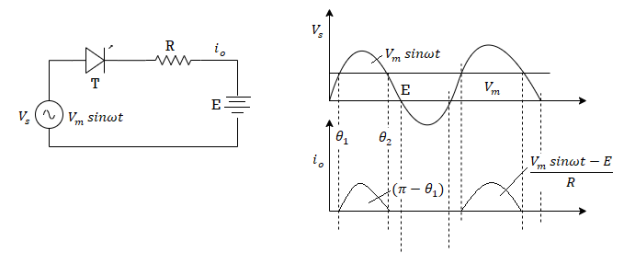
A7)
For the circuit of the voltage equation is


It is seen from fig. That SCR is turned on when  and is turned off when
and is turned off when  where
where  .
.
The battery charging requires only the average current  given by
given by


(a) Here 

(b) Power supplied to battery 
For finding the powr dissipated in R, rms value of charging current must by obtained

Power dissipated in resistor 
(c) suuply pf
Q8) A 230 V, 50 Hz one-pulse SCR controlled converter is triggered at a firing angle f of 40° and the load current extinguishes at an angle of 210°. Find the circuit turn off time, average output voltage and the average load current for
(a) 
(b) 
A8)
(a) circuit turn off time 

Average output voltage

Average load current 
(b) Fig shows that circuit turn-off time is again 8.333 m-sec average load current

Average load voltage, 
Q9) SCRs with forward voltage rating of 100 V and average on-state current rating of 40 A are used in single-phase mid-point converter and single-phase bridge converter. Find the power that these two converters can handle. Use a factor of safety of 2.5
A9)
Maximum voltage across SCR in single-phase mid-point converter is 2 
Therefore this converter can be designed for a maximum voltage of 
Maximum average power that mid-point converter can handle

SCR in a single-phase bridge converter is subjected to a maximum voltage of 
Therefore maximum voltage for which this converter can be designed is

Maximum average powr rating of bridge converter

Q10) A single phase full converter bridge is connected to RLE load. The source voltage is 230 V, 50 Hz. The average load current of 10 A is continuous over the working range. For R=0.4× and L=2m H compute
(a) firing angle delay for E=120 V
(b) firing angle delay for E=-120V
(c) In case output current is assumed constant find the input pf for both parts (a) and (b)
A10)
(a) For E=120 V the full converter is operating as a controlled rectifier


=53.208
For =53.21° power flows from ac source to dc load
(b) For E=-120 V, the full converter is operating as a line commutated inverter.

For a=124.1° the power flows from dc source to ac load
(c) For constant load current, rms value of load current  is
is

For 
For 
Q11) A single-phase half bridge inverter has a resistor load of 2.4 W and the d.c. Input voltage of 48 V. Determine:- (i) RMS output voltage at the fundamental frequency (ii) Output power P0 (iii) Average and peak currents of each transistor (iv) Peak blocking voltage of each transistor. (v) Total harmonic distortion and distortion factor. (vi) Harmonic factor and distortion factor at the lowest order harmonic.
A11)
(i) RMS output voltage of fundamental frequency, E1 = 0.9 x 48 = 43.2 V.
(ii) RMS output voltage, Eorms = E = 48 V. Output power = E 2 /R = (48)2 /2.4 = 960 W
(iii) Peak transistor current = Ip = Ed/R = 48/2.4 = 20 A. Average transistor current = Ip/2 = 10 A. (iv) Peak reverse blocking voltage, VBR = 48 V.
(iv) RMS harmonic voltage 


(vi) 
(vii) Lowest order harmonic is the third harmonic RMS value of third harmonic is



Q12) Write short note on single phase dual converter?
A12)
The dual converter comprises of two converters which can perform dual operations. The one can operate as rectifier and other as an inverter. The converters are connected antiparallel to each other. They have same supply as input. Here we can observe four quadrant operations.
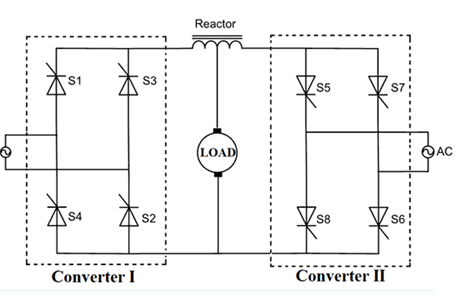
Fig. Dual Converter Circuit
The dual converter can operate in two modes-
Circulating Current Mode
- In this case both the converters are ON simultaneously. Hence, there is circulating current is present.
- The firing angles of the two converters is such that α1 + α2 =1800
- For the firing angle 0< α1<900 converter 1 acts as a controlled rectifier.
- For the firing angle 900< α2<1800 converter 2 acts as an inverter. The value of voltage Vdc and Idc both are positive.
- For the firing angle 900< α1<1800 converter 1 acts as an inverter.
- For the firing angle 0< α2<900 converter 2 acts as a controlled rectifier. The value of voltage Vdc and Idc both are negative.
Non- Circulating Current Mode
- There is no circulating current present here between the two converters because one converter acts at one time.
- For the firing angle 0< α1<900 converter 1, the value of voltage Vdc and Idc both are positive.
- For the firing angle 900< α2<1800 converter 2, the value of voltage Vdc and Idc both are negative.
Single Phase Dual Converter
When converters are operating in non-circulating mode with supply source of single phase. When input is applied to first converter is converts AC-DC (rectification). This is transferred to load after filtering. The DC from converter 1 is input to the converter 2 which acts as an inverter and generates AC as final output.
Q13) Define total harmonic distortion, transformer utilisation factor and input power factor?
A13)
Total Harmonic Distortion Factor is a measure of the distortion in the output waveform.

Where:
Is = RMS value of input supply current.
Is1 = RMS value of fundamental component of the input supply
Transformer Utilization Factor (TUF) is given as
TUF = Po(dc)/Vs x Is
Where:
VS = RMS value of transformer secondary output voltage (RMS supply voltage at the secondary).
Is = RMS value of transformer secondary current (RMS line or supply current).
The input power factor is defined as the ratio of the total mean input power to the total RMS input volt-amperes.
PF = ( V1 I1 cos φ1 ) / ( Vrms Irms)
Where V1 = phase voltage
I1 = fundamental component of the supply current
φ1 = input displacement angle
Irms = supply rms current.
Q14) Explain the working of single phase fully controlled converter with its four operating modes?
A14)

Figure. Single Phase Full Wave Bridge Converters
- Figure shows a single- phase bridge converter consisting of four valves that is valves (1-1') to (4 -4'), a capacitor to provide stiff D.C.
- Voltage and two A.C. Connection points „a‟ and „b‟. The designated valve numbers represent their sequence of turn on and turn off operation.
- The D.C. Voltage is converted to A.C. Voltage with the appropriate valve turn-off sequence is explained below:

Fig (a)

Fig (b)

Fig (c)

Fig (d)
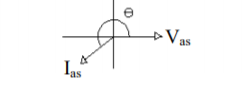
Fig (e)
- In fig (b) when devices 1and 2 are turned on voltage „Vab‟ becomes „+Vd‟ for one half cycle and when devices 3 and 4 turned off „Vab‟ becomes „- Vb‟ for the other half cycle.
- In fig (c ) Suppose the current flow ) is A.C. Wave form which is a sinusoidal wave form Iab, the angle θ leads with respect to the square-wave voltage wave form t1 the operation is illustrated.
- From instant t1 to t2 when devices 1 and 2 are ON and 3 and 4 are OFF, „Vab‟ is +ve and Iab is -ve. The current flows through device 1 into A.C. Phase “a‟ and then out of A.C. Phase “b‟ through device “2‟ with power flow from D.C. To A.C. (inverter action).
- From instant t2 to t3 the current reverses that is it becomes +ve and flows through diodes 1' and 2' with power flow from A.C. To D.C. (rectifier action)
- From instant t3 and t4 device 1 and 2 are OFF and 3 and 4 are ON, Vab becomes -ve and Iab is still +ve the current flow through devices 3 and 4 with power flow from D.C. To A.C. (inverter action).
- From instant t4 and t5 devices 3 and 4 still ON and 1 and 2 OFF Vab is -ve current Iab reverses and flows through diodes 3' and 4' with power flow from A.C. To D.C. (rectifier operation)
Fig(d) shows D.C. Current wave form and Fig (e) shows Voltage across valve (1-1') Fig (f) shows phasor of power flow from A.C. To D.C. With lagging power factor.
Four operating modes in one cycle of a single- phase converter is shown in table
ORD | Devices |  |  | Conducting devices | Conversion |
1 | 1 & 2 ON 3 & 4 OFF | +ve | -ve | 1 and 2 | Inverter |
2 | 1 & 2 ON 3 & 4 OFF | +ve | +ve | 1’ and 2’ | Rectifier |
3 | 1 & 2 ON 3 & 4 OFF | -ve | +ve | 3 and 4 | Inverter |
4 | 1 & 2 ON 3 & 4 OFF | -ve | -ve | 3’ and 4’ | Rectifier |
Q15) Derive expression for output voltage and current of signle phase fully controlled rectifier?
A15)

Where 


Therefore the RMS value of the nth harmonic

RMS value of  can of course be completer directly from
can of course be completer directly from


Where 
Now at steady state  since
since  is periodic over the chosen into boundary condition we obtain
is periodic over the chosen into boundary condition we obtain

The input current  is related to
is related to  as follows:
as follows:

 otherwise
otherwise
Q16) What are half controlled converters? Explain with its output waveform and circuit diagram?
A16)
Fig (a) below shows a single-phase half-controlled (semiconverter) rectifier. This configuration consists of a combination of thyristors and diodes and used to eliminate any negative voltage occurrence at the load terminals. This is because the diode Df is always activated (forward biased) whenever the load voltage tends to be negative. For one total period of operation of this circuit, the corresponding waveforms are shown in Fig.(b) below.
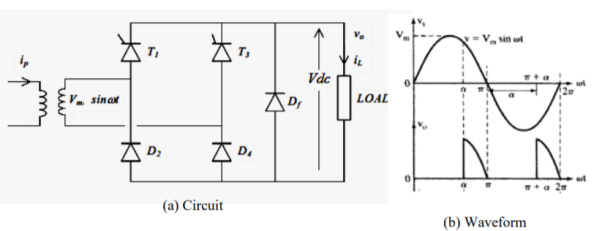
Fig. Semi-converter
The average value of the load voltage Vdc can be calculated as follows


Therefore, the average output voltage can vary from 0 to Vm /π when varying α from π to 0 respectively.
The average value of the load current Idc as follows

The rms value of the load voltage Vrms can be calculated as follows


The diode D2 and D4 conducts for the positive and negative half cycle of the input voltage waveform respectively. On the other hand T1 starts conduction when it is fired in the positive half cycle of the input voltage waveform and continuous conduction till T3 is fired in the negative half cycle. Figure below shows the circuit diagram and the waveforms of a single phase half controlled converter supplying an R – L – E load.
Q17) Derive expression for average load output voltage for half controlled thyristor rectifier with R load?
A17)
Figure Shows the circuit diagram of Single Phase Half Wave Controlled Rectifier with Resistive Load. In this Circuit, an SCR ( T ) is used to rectify the incoming Sine Wave from the Input, and this rectified output will be supplied to an Resistive load.
V0 = Load output voltage
i0 = Load current
VT = Voltage across the Thyristor
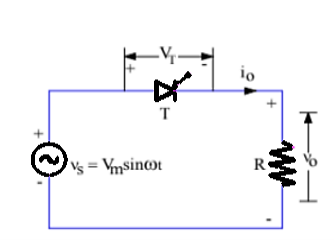
Fig. Single phase half wave controlled rectifier
During the Positive Half Cycle of the Input Supply, the SCR (T) is forward biased. The load output voltage is zero till SCR triggered. During this cycle, the SCR is Triggered at a firing angle ωt = α and SCR (T) will Start conducting. But as soon as the supply voltage becomes zero at ωt = π, the load current will become zero
After ωt = π (During Negative Half Cycle ), SCR ( T ) is reversed biased and will Turned OFF at ωt = π and will remain in OFF condition till it is fired again at ωt = (2π+α).The wave shapes for voltage and current in case of Resistive load are shown below:
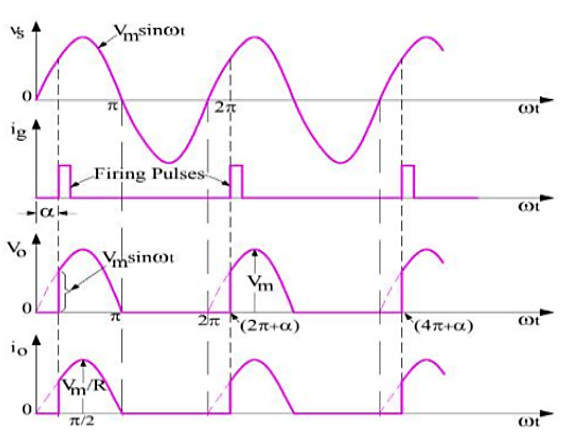
Fig. Waveform
Therefore, the load output voltage and current for one complete cycle of input supply voltage may be written as



Calculation of Average Load Output Voltage:
As we know that, average value of any function f(x) cab be calculated using the formula
Let us now calculate the average value of output voltage for Single Phase Half Wave Controlled Rectifier.
Average value 
Let us now calculate the average value of output voltage for single phase half wave controlled rectifier.
Average value of load output voltage


Since the value of load output voltage is zero from  and
and  , therefore
, therefore



From the expression of average output voltage, it can be seen that, by changing firing angle α, we can change the average output voltage.
The average output voltage is maximum when firing angle is zero and it is
Minimum when firing angle α = π. This is the reason, it is called phase
Controlled rectifier. Average load current for Single Phase Half Wave Controlled Rectifier can easily be calculated by dividing the average load output voltage by load resistance R.
Q18) What are freewheeling diodes? What is the purpose of using them?
A18)
A freewheeling diode is basically a diode connected across the inductive load terminals to prevent the development of high voltage across the switch. When the inductive circuit is switched off, this diode gives a short circuit path for the flow of inductor decay current and hence dissipation of stored energy in the inductor. This diode is also called Flywheel or Fly-back diode.
Purpose of using Freewheeling Diode:
1. The Freewheeling Diode improves the waveform of the load current of Rectifier
Circuits, inverter circuits, and chopper circuits by making it continuous.
2. The Freewheeling protect the SCRs from damage in the circuits with Inductive Load
From the excessive reverse voltage creating by the Inductive Load.
3. The Freewheeling Diode improves the Input Power Factor of Phase controlled
Rectifiers.
4. The Freewheeling diode sustains the average output voltage of the circuit with
Inductive Load.
5. It also helps to reduce Ripple components in the output signal of the circuit with
Inductive Load.
Q19) Explain working of full wave fully controlled bridge rectifier with RL load?
A19)
In the Full Wave Fully-Controlled Rectifier Configuration, the average DC load voltage is controlled using two thyristors / SCRs per half-cycle. Thyristors T1 and T2 are fired together as a pair during the positive half-cycle, While thyristors T3 and T4 are also fired together as a pair during the negative half-cycle ( i.e. 180oafter T1 and T2).
When the load is Inductive, the Output Voltage can be Negative for part of the cycle. This is because an inductor stores energy in its magnetic field which is later released. The Circuit Diagram Full Wave Full controlled rectifier with R-L Load is as shown below
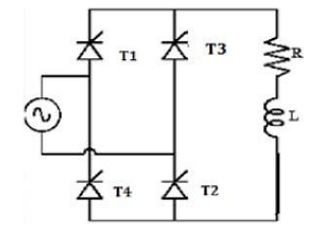
Fig. Circuit for full wave fully controlled rectifier with RL load
Operation of this mode can be divided between four modes
Mode 1 (α to π)
In positive half cycle of applied ac signal, SCR's T1 & T2 are forward biased & can be turned on at an angle α. Load voltage is equal to positive instantaneous AC supply voltage. The load current is positive, ripple free, constant and equal to Io. Due to positive polarity of load voltage & load current, load inductance will store energy.
Mode 2 (π to π + α)
At wt = π, input supply is equal to zero & after π it becomes negative. But inductance opposes any change through it. In order to maintain a constant load current & also in same direction. A self-induced emf appears across 'L' as shown. Due to this induced voltage, SCR's T1 & T2 are forward biased in spite the negative supply voltage. The load voltage is negative & equal to instantaneous ac supply voltage whereas load current is positive. Thus, load acts as source & stored energy in inductance is returned back to the ac supply.
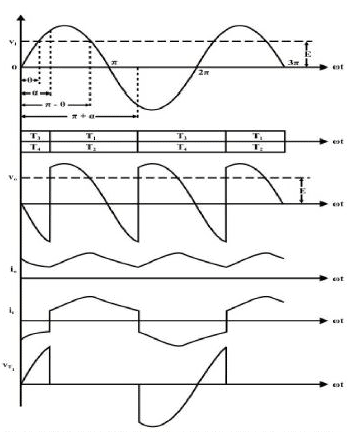
Fig. Waveform
Mode 3 (π + α to 2π)
At wt = π + α, SCR's T3 & T4 are turned on & T1, T2 are reversed bias. Thus, process of conduction is transferred from T1, T2 to T3, T4. Load voltage again becomes positive & energy is stored in inductor T3, T4 conduct in negative half cycle from (π + α) to 2 π. With positive load voltage & load current energy gets stored.
Mode 4 (2 π to 2 π + α)
At wt = 2π, input voltage passes through zero. Inductive load will try to oppose any change in current if in order to maintain load current constant & in the same direction. Induced e. m. f. Is Positive & maintains conducting SCR's T3 & T4 with reverse polarity also.
Thus, VL is negative & equal to instantaneous AC supply voltage. Whereas load current continues to be positive. Thus, load acts as source & stored energy in inductance is returned back to ac supply At wt = α or 2 π + α, T3 & T4 are commutated and T1,T2 are turned ON.
Q20) Derive the expression of the DC Output Voltage and RMS voltage of A Single Phase Semi Converter with R, L, & E Load & FWD?
A20)
The DC Output Voltage and RMS voltage of A Single Phase Semi Converter with R, L, & E Load & FWD





 can be varied from a max value of
can be varied from a max value of  to 0 by varying from 0 to π.
to 0 by varying from 0 to π.
For =0, The max. Dc o/p voltage obtained is

Normalized dc o/p voltage is

(ii) RMS O/P Voltage 


